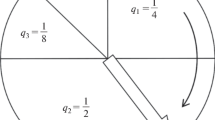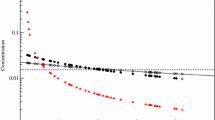Abstract
The theory of autocatalytic binary ligation is reviewed within the context of a consistently applied Michaelis-Menten quasi-steady-state approximation to obtain explicit analytical results describing time-course data from experiments. A detailed protocol for the step-wise elucidation of a minimal set of experimental parameters is outlined. The kinetic equations are then generalized to cases of self-and cross-catalysis among an arbitrary number of different templates and applied to experiments involving just two templates. Depending on the values of various kinetic parameters such systems can display exclusionary Darwinian selection corresponding to an exponential growth law, selective coexistence or coexistence of all species characteristic of a parabolic growth law; the intermediate behaviour arises as a property of the full mechanism analysed here. Our results are applicable to the classical case of self-replicating nucleic acids and their analogues as well as to newly discovered self-replicating peptides.
Similar content being viewed by others
References
Achilles, T. and G. von Kiedrowski (1993). A self-replicating system from three starting materials. J. Angew. Chem. Int. Edn. engl. 32, 1198–1201.
Biebricher, C., M. Eigen, and W. C. Gardiner, Jr (1991). Quantitative analysis of selection and mutation in self-replicating RNA, in Biologically Inspired Physics, L. Peliti (Ed.), New York: Plenum Press, pp. 317–337.
Biebricher, C. K., M. Eigen, W. C. Gardiner Jr and R. Lute (1985). Kinetics of RNA replication: Plus-minus asymmetry and double strand formation. Biochemistry 24, 3186–3194.
Borghans, J. A. M., R. J. de Boer, and L. A. Segel (1996). Extending the quasi-steady state approximation by changing variables. Bull. Math. Biol. 58, 43–63.
Eigen, M. (1971). Selforganization of matter and the evolution of macromolecules. Naturwiss. 58, 465–523.
Eigen, M., J. S. McCaskill, and P. Schuster. The molecular quasi-species. Adv. Chem. Phys. 75, 149–263.
Eigen, M. and P. Schuster (1979). The Hypercycle. New York, Berlin: Springer-Verlag.
Famulok, M., J. Nowick, and J. Rebek Jr (1992). Self-replicating systems. Act. Chim. Scand. 46, 315–324.
Hecht, R., R. Happel, P. Schuster, and P. F. Stadler (1997). Autocatalytic networks with intermediates I: Irreversible reactions. Math. Biosc. 140, 33–74.
Hirsch, M. W. and S. Smale (1974). Differential Equations, Dynamical Systems and Linear Algebra. New York: Academic Press.
Hofbauer, J. (1985). The selection mutation equation. J. Math. Biol. 23, 41–53.
Hofbauer, J. and K. Sigmund (1988). Dynamical Systems and the Theory of Evolution, Cambridge: Cambridge University Press.
Hutson, V. and K. Schmitt (1992). Permanence and the dynamics of biological systems. Math. Biosc. 111, 1–71.
James, K. D. and A. D. Ellington (1995). The search for missing links between self-replicating nucleic acids and the RNA world. Origins Life Evol. Biosphere 25, 515–530.
James, K. D. and A. D. Ellington (1997). Catalysis in the RNA world, in The Molecular Origins of Life, A. Brack (Ed.), Cambridge: Cambridge University Press.
Kauffman, S. A. (1996). Investigations, Technical report, Santa Fe Institute, Santa Fe, NM. #96-08-072.
Lee, D. H., J. R. Granja, J. A. Martinez, K. Severin, and M. R. Ghadiri (1996). A self-replicating peptide. Nature 382, 525–528.
Lee, D. H., K. Severin, Y. Yokobayashi, and M. R. Ghadiri (1997). Emergence of symbiosis in peptide self-replication through a hypercyclic network. Nature 390, 591–594.
Michaelis, L. and M. I. Menten (1913). Die Kinetic der Invertinwirkung. Biochem. Z. 49, 333–369.
Rotello, V., J.-I. Hong, and J. Rebek Jr (1991). Sigmoidal growth in a self-replicating system. J. Amer. Chem. Soc. 113, 9422–9424.
Schuster, P., K. Sigmund, and R. Wolff. Dynamical systems under constant organization III: Cooperative and competitive behaviour of hypercycles. J. Diff. Eqns 32, 357–368.
Segel, L. A. and M. Slemrod (1989). The quasi-steady state assumption: a case study in perturbation. SIAM Rev. 31 446–477.
Sievers, D. and G. von Kiedrowski (1994). Self-replication of complementary nucleotide-based oligomers. Nature 369, 221–224.
Stadler, B. M. R. and P. F. Stadler (1991). Dynamics of small autocatalytic reaction networks III: Monotonous growth functions. Bull. Math. Biol. 53, 469–485.
Stadler, P. F. (1991). Complementary replication. Math. Biosci. 107, 83–109.
Stadler, P. F., W. Schnabl, C. V. Forst, and P. Schuster (1995). Dynamics of autocatalytic reaction networks II: Analytically treatable special cases. Bull. Math. Biol. 57, 21–61.
Stadler, P. F. and P. Schuster (1992). Mutation in autocatalytic networks—an analysis based on perturbation theory. J. Math. Biol. 30, 597–631.
Szathmáry, E. and I. Gladkih (1989). Sub-exponential growth and coexistence of non-enzymatically replicating templates. J. Theor. Biol. 138, 55–58.
Terfort, A. and G. von Kiedrowski (1992). Self-replication by condensation of 3-aminobenzamidines and 2-formylphenoxyacetic acids. Angew. Chem. Int. Ed. engl. 31, 654–665.
Varga, S. and E. Szathmáry (1997). An extremum principle for parabolic competition. Bull. Math. Biol. 59, 1145–1154.
von Kiedrowski, G. (1986). A self-replicating hexadeoxynucleotide. Angew. Chem. Int. Ed. Engl. 25, 932–935.
von Kiedrowski, G. (1993). Minimal replicator theory I: Parabolic versus exponential growth, in Bioorganic Chemistry Frontiers, Col. 3, Berlin, Heidelberg: Springer-Verlag, pp. 115–146.
von Kiedrowski, G., B. Wlotzka, and I. Helbing (1989). Sequence dependence of template-directed syntheses of hexadeoxynucleotide derivatives with 3’-5’ pyrophosphate linkage. J. Angew. Chem. Int. Edn. engl. 28, 1235–1237.
Zielinski, W. S. and L. E. Orgel. Autocatalytic synthesis of a tetranucleotide analogue. Nature 327, 346–347.
Author information
Authors and Affiliations
Corresponding author
Rights and permissions
About this article
Cite this article
Wills, P.R., Kauffman, S.A., Stadler, B.M.R. et al. Selection dynamics in autocatalytic systems: Templates replicating through binary ligation. Bull. Math. Biol. 60, 1073–1098 (1998). https://doi.org/10.1006/S0092-8240(98)90003-9
Received:
Accepted:
Issue Date:
DOI: https://doi.org/10.1006/S0092-8240(98)90003-9




